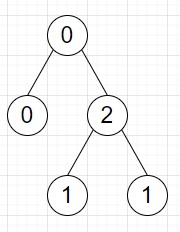
 Data Structure
Data Structure Networking
Networking RDBMS
RDBMS Operating System
Operating System Java
Java MS Excel
MS Excel iOS
iOS HTML
HTML CSS
CSS Android
Android Python
Python C Programming
C Programming C++
C++ C#
C# MongoDB
MongoDB MySQL
MySQL Javascript
Javascript PHP
PHP
- Selected Reading
- UPSC IAS Exams Notes
- Developer's Best Practices
- Questions and Answers
- Effective Resume Writing
- HR Interview Questions
- Computer Glossary
- Who is Who
Program to count how many ways we can divide the tree into two trees in Python
Suppose we have a binary tree containing values 0, 1 and 2. The root has at least one 0 node and one 1 node. Now suppose there is an operation where we delete an edge in the tree and the tree becomes two different trees. We have to find the number of ways we can delete one edge such that none of the two trees contain both a 0 node and a 1 node.
So, if the input is like

then the output will be 1 as we can only delete the 0 to 2 edge.
To solve this, we will follow these steps −
- count := [0, 0, 0]
- Define a function dfs() . This will take node
- if node is not null, then
- pre := count
- dfs(left of node)
- dfs(right of node)
- count[value of node] := count[value of node] + 1
- node.count := a list of (count[i] - pre[i]) for i is 0 and 1
- Define a function dfs2() . This will take node, par
- if node is not null, then
- if par is not null, then
- (a0, a1) := count of node
- (b0, b1) := (count[0] - a0, count[1] - a1)
- if (a0 is same as 0 or a1 is same as 0) and (b0 is same as 0 or b1 is same as 0), then
- ans := ans + 1
- dfs2(left of node, node)
- dfs2(right of node, node)
- if par is not null, then
- From the main method, do the following −
- dfs(root)
- ans := 0
- dfs2(root)
- return ans
Let us see the following implementation to get better understanding −
Example
class TreeNode: def __init__(self, data, left = None, right = None): self.val = data self.left = left self.right = right class Solution: def solve(self, root): count = [0, 0, 0] def dfs(node): if node: pre = count[:] dfs(node.left) dfs(node.right) count[node.val] += 1 node.count = [count[i] - pre[i] for i in range(2)] dfs(root) def dfs2(node, par=None): if node: if par is not None: a0, a1 = node.count b0, b1 = count[0] - a0, count[1] - a1 if (a0 == 0 or a1 == 0) and (b0 == 0 or b1 == 0): self.ans += 1 dfs2(node.left, node) dfs2(node.right, node) self.ans = 0 dfs2(root) return self.ans ob = Solution() root = TreeNode(0) root.left = TreeNode(0) root.right = TreeNode(2) root.right.left = TreeNode(1) root.right.right = TreeNode(1) print(ob.solve(root))
Input
root = TreeNode(0) root.left = TreeNode(0) root.right = TreeNode(2) root.right.left = TreeNode(1) root.right.right = TreeNode(1)
Output
1

Advertisements
